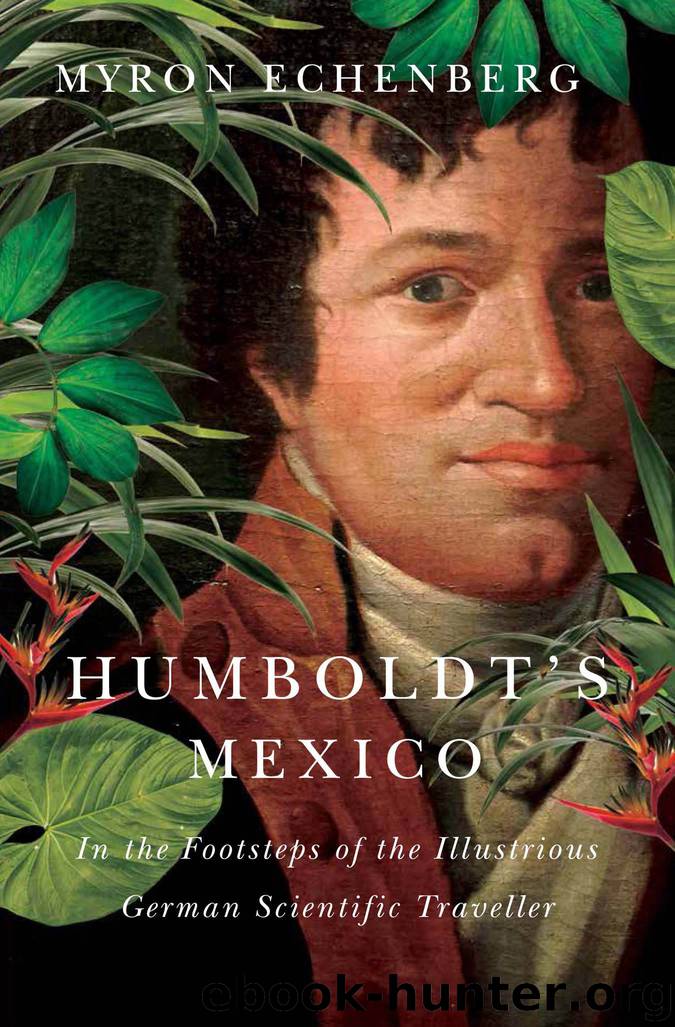Humboldt's Mexico by Myron Echenberg

Author:Myron Echenberg
Language: eng
Format: epub
Publisher: MQUP
Published: 2017-08-25T16:00:00+00:00
PART TWO
Visits to the Mexican Heartland, 14 May to 10 October 1803: Silver Mines and Active Volcanoes
CHAPTER 11
Pachuca, Land of Mines, and Mining Haciendas
Pachuca was the second silver-mining region visited by Humboldt in 1803. It owed its prominence to the discoveries of Pedro Romero de Terreros, a Spaniard who was another of the larger than life personalities in the history of colonial Mexican mining. After the usual pattern of decline had taken place, significant increases in silver production occurred in the early eighteenth century. A mercantile company owned the Pachuca mines, and by 1760, Romero had emerged as the sole owner at Real del Monte.
Romero was born to a prominent family on 10 July 1710 in Cartagena, Spain. He studied at the University of Salamanca and in 1730 went to Mexico to resolve the estate of a deceased brother. He settled in Querétaro, where his uncle, who was ill, lived, and he took over the successful business of transporting goods from Veracruz throughout Mexico. For a time, he was mayor of Querétaro, but when a Real del Monte miner named José Alejandro Bustamante needed more capital to extend his mine, Romero joined him in the venture.
The mines in Pachuca formed part of the Veta Vezcaína. Three times, owners had abandoned these mines because of flooding. It was a risky investment, and some miners had even purchased English machinery costing 100,000 pesos in an unsuccessful effort to return the mines to profitability. Romero’s efforts became the very model of successful renovation of an older mine. When Bustamante died, Romero inherited his debts and assets in Pachuca. He built a huge tunnel, an expensive undertaking lasting thirteen years, as well as a vast refining mill costing nearly 500,000 pesos. It had two covered patios, water wheels, and furnaces. He recruited voluntary workers, but also drafted Indian labour from villages within a fifty-kilometre radius of Real del Monte. Romero was opposed by Indian alcaldes, Spanish and creole landowners, and parish priests of the area who insisted Indian labour was best suited to agriculture. Drafted Indian labour had declined to negligible proportions during the course of the eighteenth century.
In 1776, when Romero attempted to cut wages, a major strike closed down the mines and workers murdered the local magistrate who tried to arbitrate. Nine years later, Romero was obliged to back down. His difficulties with labour notwithstanding, Romero was a highly successful entrepreneur. His success demonstrated that mining once again attracted investors. Romero invested only in Real del Monte and in the purchase of local haciendas, unlike other mining barons who invested in other silver mines. Among his properties in Real del Monte were the Hacienda San Miguel Regla, the Santa María Regla, and the San Antonio. He also bought confiscated Jesuit estates in Tepotzotlán and Mexico City from the Crown to give to his sons, turning a tidy profit in this way.
Romero bought a title for himself and became the Count of Regla in 1769. He purchased two others for his sons, who became the marquises of San Cristóbal and San Francisco.
Download
This site does not store any files on its server. We only index and link to content provided by other sites. Please contact the content providers to delete copyright contents if any and email us, we'll remove relevant links or contents immediately.
Endurance: Shackleton's Incredible Voyage by Alfred Lansing(3834)
Tokyo Vice: An American Reporter on the Police Beat in Japan by Jake Adelstein(3436)
The Motorcycle Diaries by Ernesto Che Guevara(3326)
Alive: The Story of the Andes Survivors by Piers Paul Read(3304)
Apollo 8 by Jeffrey Kluger(3196)
Exit West by Mohsin Hamid(3174)
Aleister Crowley: The Biography by Tobias Churton(3016)
Annapurna by Maurice Herzog(2834)
Full Circle by Michael Palin(2764)
Into Thin Air by Jon Krakauer(2695)
A Wilder Time by William E. Glassley(2358)
Kitchen confidential by Anthony Bourdain(2299)
In Patagonia by Bruce Chatwin(2263)
Finding Gobi by Dion Leonard(2253)
Into the Wild by Jon Krakauer(2118)
L'Appart by David Lebovitz(2113)
The Ogre by Doug Scott(2105)
An Odyssey by Daniel Mendelsohn(1918)
The Stranger in the Woods by Michael Finkel(1918)
